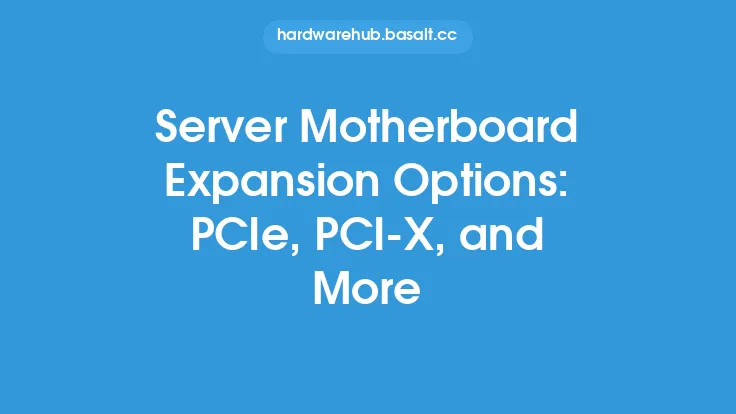When it comes to upgrading or expanding a motherboard, one of the most critical components to consider is the chipset. The chipset plays a vital role in determining the motherboard's capabilities, features, and overall performance. In this article, we will delve into the world of chipsets and explore how they affect motherboard upgrade and expansion options.
Chipset Types and Their Impact on Upgrade Options
The type of chipset used on a motherboard can significantly impact its upgrade options. For example, high-end chipsets like the Intel Z-series or AMD X-series offer more features and capabilities, such as overclocking, multiple GPU support, and high-speed storage options. These chipsets are designed for enthusiasts and gamers who require high-performance systems. On the other hand, budget-friendly chipsets like the Intel B-series or AMD A-series may limit upgrade options, such as fewer USB ports, limited storage options, and no overclocking support.
Expansion Options and Chipset Limitations
The chipset also determines the expansion options available on a motherboard. For instance, the number of PCIe slots, SATA ports, and USB ports are all dictated by the chipset. High-end chipsets often provide more PCIe slots, allowing for multiple graphics cards, sound cards, or other peripherals to be installed. In contrast, budget chipsets may only offer a single PCIe slot, limiting the user's ability to expand their system. Additionally, the chipset may limit the speed of certain interfaces, such as USB or SATA, which can impact the performance of connected devices.
Overclocking and Chipset Capabilities
Overclocking is a popular feature among enthusiasts, and the chipset plays a crucial role in determining the motherboard's overclocking capabilities. High-end chipsets often provide more advanced overclocking features, such as multiplier adjustments, voltage control, and memory tweaking. These features allow users to push their systems to the limit, achieving higher clock speeds and improved performance. However, budget chipsets may not offer these features, or may limit the extent to which the system can be overclocked.
Storage Options and Chipset Support
The chipset also affects the storage options available on a motherboard. For example, high-end chipsets may support faster storage interfaces like NVMe or U.2, while budget chipsets may only support slower interfaces like SATA III. Additionally, the chipset may limit the number of storage devices that can be connected, or may not support certain types of storage devices, such as M.2 SSDs.
Networking and Audio Capabilities
The chipset can also impact the networking and audio capabilities of a motherboard. For instance, high-end chipsets may provide more advanced networking features, such as Wi-Fi, Ethernet, or high-speed LAN. These features can improve the system's connectivity and online gaming performance. Similarly, the chipset may affect the audio capabilities of the motherboard, with high-end chipsets often providing more advanced audio features, such as high-definition audio or audio shielding.
Power Delivery and Chipset Limitations
The chipset can also limit the power delivery capabilities of a motherboard. For example, high-end chipsets may provide more power phases, allowing for more powerful CPUs and GPUs to be installed. In contrast, budget chipsets may only provide a limited number of power phases, which can limit the system's ability to handle high-power components.
Conclusion and Future Developments
In conclusion, the chipset plays a vital role in determining the upgrade and expansion options available on a motherboard. The type of chipset used can impact the system's performance, features, and capabilities, making it essential to choose a motherboard with a chipset that meets your needs. As technology continues to evolve, we can expect to see more advanced chipsets with improved features and capabilities. For example, upcoming chipsets may support faster storage interfaces, improved networking capabilities, or more advanced audio features. By understanding the role of the chipset in motherboard upgrade and expansion options, users can make informed decisions when building or upgrading their systems, ensuring they get the most out of their hardware.





